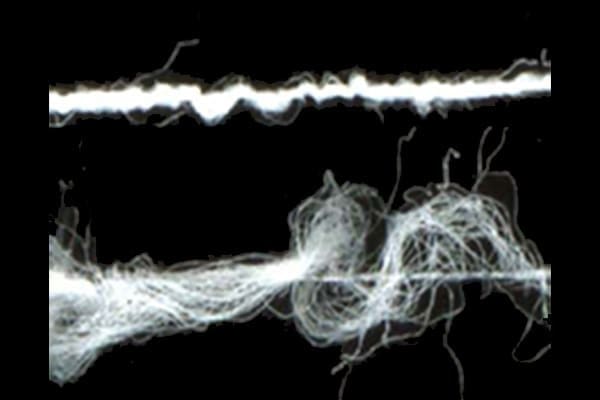Core spun yarn is characterized by having a central core wrapped with staple fibres. These are produced in a single operation by simultaneously feeding a core filament and staple fibres through the delivery rollers of a spinning frame.

Core-spun yarns are two-component structure with Core and sheath.
Methods for production of Core spun yarns
- Conventional core spinning attachment with ring spinning systems
- R.R.C Core wrap spinning method
- R.S. Patterned Spinning system
- Core-twin spinning system
- Composite electrostatic spinning system
- Rotor spinning system
- Friction spinning system and
- Air jet spinning system
Effect of Process variables in Ring Core-spun yarn properties
- Core- sheath ratio:
It has been found that decreasing sheath content will increase the strength of the core-spun yarn. - Pre- tension to Core material:
The pretension is needed to regulate the geometrical position of the filament. This input tension varies with the twist factor, size and the quality of the filaments used. - Spinning draft
Spinning drafts can be varied to obtain the required yarn count based on the core the sheath ratio. - Filament at the sides of the roving
- Number of Roving feeds:
The possible ways of feeding the core material at the front roller nip with respect to roving are: - Filament in the centre of the roving.
- Filament on the top of the roving.
- Twist
Adequate cohesion obtained in individual yarns at high twist rates and it minimizes the sheath slippage. The extension of the core-spun yarn tends to reduce at higher twist levels.
Core-spun yarn production by Rotor spinning system
- Twist efficiency and pre-tension of filament are the influencing factors in core spinning.
- The doffing tube was mounted on a ball bearing, rotated by a separate drive opposite to the rotation of the rotor with a speed ratio of 1:9.
The core is not twisted during this process. It is economical to produce coarse core-spun yarns through a rotor machine than the ring core-spun yarns.

Core-spun yarn production by Friction spinning system
- In friction spinning system, the fibres are individually Undergoes the processes- collecting and twisting – to form yarn.
- It processes a wide range of staple length.
- The rotation of the friction drums falsely twists the core.
Core-spun yarn production by the MJS spinning system
- Air-jet spinning is for producing core yarns after optimizing process parameters.
- A relatively higher first nozzle pressure is advantageous for improving sheath-slippage resistance.
- The use of higher spinning speed and wider condenser markedly improves the tenacity, breaking extension, initial modulus and sheath-slippage resistance and affects the yarn hairiness, mass irregularity and flexural rigidity.

Core-spun sewing threads

- Doubling:
Two or three ends twist together to make sewing thread. This twisting process improves the cotton covering of the core-spun yarn
- Heat set:
Fibres and filaments used for the spinning core yarns have different characteristics. The yarn may shrink differently. So, to achieve balance and set of these yarns, heat setting has to be done.
- Hot stretching:
Hot stretching is a process of heating the thread to a pre-determined and controlled temperature in the range of 180-240X. This helps to get improvement in dyeing and kink free sewing thread.
- Wet processing:
Threads convert into hank form for required wet processing treatments. High colour fastness and precise shade matching are the key factor requirements for Core-spun sewing threads.
- Lubrication
Gliding and cooling effect on the needle could be done with effective lubricants. The lubricant must allow the thread to unwind evenly from the package. - Final Winding:
The core spun sewing thread wound on a suitable package like a spool, a cop or king spool with the required length.
Advantages of Core-spun yarns
- Development of core-spun yarn with ring spinning system unveils path for new products
- It has high performance due to its exceptional strength.
- Ideal wash and wear performance and permanent press.
Applications of Core-Spun yarn
- Core spun yarns are inherently fire-resistant fibres.
- To make fire barriers for mattresses and furniture.

